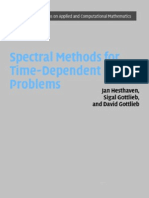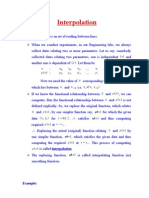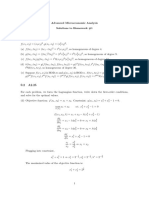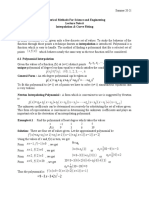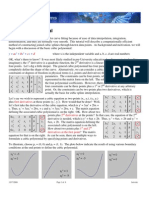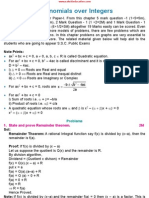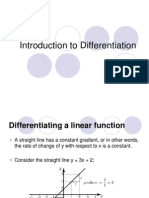Curve Interpolation. Newton's Divided Differences. Lagrange Polynomials
Curve Interpolation. Newton's Divided Differences. Lagrange Polynomials
Uploaded by
Ahmet GelisliCopyright:
Available Formats
Curve Interpolation. Newton's Divided Differences. Lagrange Polynomials
Curve Interpolation. Newton's Divided Differences. Lagrange Polynomials
Uploaded by
Ahmet GelisliOriginal Title
Copyright
Available Formats
Share this document
Did you find this document useful?
Is this content inappropriate?
Copyright:
Available Formats
Curve Interpolation. Newton's Divided Differences. Lagrange Polynomials
Curve Interpolation. Newton's Divided Differences. Lagrange Polynomials
Uploaded by
Ahmet GelisliCopyright:
Available Formats
Lecture 5 Curve Interpolation. Newtons Divided Differences.
Lagrange Polynomials
5.1. INTERPOLATING AND APPROXIMATING POLYNOMOALS In general, free form ship curves, i.e., frame, waterline, buttock lines, are given in tabular forms as follows:
Mathematical representation of ship lines will require to generate an approximating function that will allow an estimation of the offset value y for x xi, i = 1, 2, , n. It may be assumed that these offset points are defined by a non-analytic function y = f(x). We wish to approximate f(x) by a suitable analytic function g(x) which has the general characteristic shape. The algebraic polynomials are the most important and popular approximating functions. Polynomials are easy to evaluate and their sums, products and differences are also polynomials. Polynomials can be differentiated and integrated easily, yielding other polynomials in both cases. The polynomials can be simply divided into two categories; interpolating and approximating polynomials. Examples of interpolating and approximating polynomials are illustrated in Figures 5.1 a and 5.1.b, respectively.
Figure 5.1 a
Figure 5.1 b
Given a set of n ordered data points (xi, yi), i = 0,1,, n 1, let y = p(x) be a polynomial of degree n 1 in x with unknowns a0, a1, , an 1. That p(x) traverses through data points above implies 2 3 n 1 ) y0 = p ( x 0 ) = a0 + a1 x0 + a2 x0 + a3 x0 + ... + an 1 x0 y1 = p ( x1) = a0 + a1 x1 + a2 x12 + a3 x13 + ... + an 1 x1n 1 )
2 3 n 1 ) y2 = p ( x 2 ) = a0 + a1 x2 + a2 x2 + a3 x2 + ... + an 1 x2
(5.1)
...
2 3 n 1 yn 1 = p ( x n 1) = a0 + a1 xn 1 + a2 xn 1 + a3 xn 1 + ... + an 1 xn 1 )
which is a system of n linear equations in ai, i = 0,1,, n 1, and can be solved by inverting an nn matrix. The n equations can be given in matrix form as: n 1 1 x0 a0 y0 x0 x1n 1 a1 y1 1 x1 = n 1 1 xn 1 xn 1 an 1 yn 1
There is unique solution for the ai, and hence there is only one polynomial p(x) which exactly produces yi values. This type of polynomial may be ideal for representing simple sections; however, for high values of n (degree of the polynomial) the linear system of equations can produce illconditioning. Also, it is computationally expensive to change one of the points, since the entire system has to be resolved. It is possible to reduce some effort in computation by posing the interpolating polynomial in a slightly different manner. 5.2. NEWTONS DIVIDED DIFFERENCES In the Newtons divided differences approach, the polynomial is presented as y p ( x) = a0 + a1 ( x x0 ) + a2 ( x x0 )( x x1 ) + ... + an 1 ( x x0 )( x x1 )( x xn 2 ) so that at the data points, the equations in unknowns ai take the form y 0 p ( x0 ) = a 0 a0 = y 0 y a y1 p( x1 ) = a0 + a1 ( x1 x0 ) a1 = 1 0 x1 x0 (5.2)
y2 p( x2 ) = a0 + a1 ( x2 x0 ) + a2 ( x2 x0 )( x2 x1 )
a2 =
y2 a0 a1 ( x2 x0 ) ( x2 x0 )( x2 x1 )
yn1 p( xn1 ) = a0 + a1 ( x2 x0 ) + a2 ( x2 x0 )( x2 x1 ) + ... + an1 ( xn1 x0 )( xn1 x1 )( xn1 xn2 )
an1 =
yn1 a0 a1 ( xn1 x0 ) an2 ( xn1 x0 )( xn1 x1 )...( xn1 xn2 ) ( xn1 x0 )( xn1 x1 )...( xn1 xn2 )
The unknowns ai are determined by a series of forward substitutions. Note that a0 depends only on y0, a1 depends on y0 and y1, a2 depends on y0, y1 and y2, and so on. If, additionally, a new data point, (xn, yn) is introduced, an equation is further added with only one unknown an to be determined, that is, the addition of a new data point does not alter the previously calculated coefficients. This is in contrast to the system of equations in (5.1) wherein the addition of a data point requires all the n + 1 coefficients to be recomputed by inverting an (n + 1)(n + 1) matrix. 5.3. LAGRANGE POLYNOMIALS
The third possibility in curve interpolation due to Lagrange does not require computing the coefficients and can be elucidated using the following example. For three data points (x0, y0), (x1, y1) and (x2, y2), consider the expression
L2 0 ( x) =
( x x1 )( x x2 ) ( x0 x1 )( x0 x2 )
(5.3)
2 On setting x=x0. L2 0 ( x ) becomes unity, however, for x=x1 or x2, L0 ( x ) =0. ( x x0 )( x x2 ) 2 ( x) = is 1 for x=x1 and 0 for x=x0 and x=x2 and that Similarly, L1 ( x1 x0 )( x1 x2 ) ( x x0 )( x x1 ) is 1 for x=x2 and 0 for x=x0 and x=x1 . L2 2 ( x) = ( x2 x0 )( x2 x1 )
2 2 Using the functions L2 0 ( x ) , L1 ( x ) and L2 ( x ) which are all quadratic in x (the superscript denotes the degree in x), and the y values, we can construct a quadratic function
2 2 PL2 = L2 0 ( x ) y0 + L1 ( x ) y1 + L2 ( x ) y2
(5.4)
1 which passes through the three data points. In general, Ln i ( x ) are termed as Lagrangian 1 interpolation coefficients where the subscript i signifies that Ln i ( x ) is the weight of yi in Eq. (5.6). The superscript n 1 denotes the degree of interpolating polynomial. By inspection from 1 Eq. (5.3) and the related expressions, Ln i ( x ) may be written as n 1 (x x j ) ( x x0 )...( x xi 1 )( x xi +1 )...( x xn 1 ) 1 (5.5) Ln ( x ) = = i ( xi x0 )...( xi xi 1 )( x xi +1 )...( xi xn 1 ) j = 0 ( xi x j )
j i
The interpolating polynomial than becomes
1 PLn 1 ( x) = Ln i ( x ) yi i =0 n 1
(5.6)
5.4.
EXAMPLES
Consider a bulb ship profile defined by 4 points. Find the interpolating polynomial using Newtons divided differences approach and Lagrange polynomials. (see also Figure 5.1)
x y 0 0 3 6 6 2 9 8
5.4.1 Newtons divided differences approach
Since there are fore data points (n=4) the polynomial is a cubic (degree =3), that is y = a0 + a1 ( x x0 ) + a2 ( x x0 )( x x1 ) + a3 ( x x0 )( x x1 )( x x2 ) Now a0 = y 0 = 0 y a0 6 0 a1 = 1 =2 = x1 x0 3 0 ( y a0 ) a1 ( x2 x0 ) (2 0) 2(6 0) 10 a2 = 2 = = ( x2 x0 )( x2 x1 ) (6 0)(6 3) 18 ( y a0 ) a1 ( x3 x0 ) a2 ( x3 x0 )( x3 x1 ) (8 0) 2(9 0) + 10 / 18(9 0)(9 3) 10 = = a3 = 3 ( x3 x0 )( x3 x1 )( x3 x2 ) (9 0)(9 3)(9 6) 81 The polynomial becomes 10 10 y = 2 x x( x 3) + x( x 3)( x 6) 18 81
5.4.2 Lagrange polynomials
Since n=4 the degree of Lagrange polynomial is n-1=3 3 3 3 y = L3 0 ( x ) y0 + L1 ( x ) y1 + L2 ( x ) y 2 + L3 ( x ) y3 or
y= +
( x x1 )( x x2 )( x x3 ) ( x x0 )( x x2 )( x x3 ) ( x x0 )( x x1 )( x x3 ) y0 + y1 + y2 + ( x0 x1 )( x0 x2 )( x0 x3 ) ( x1 x0 )( x1 x2 )( x1 x3 ) ( x2 x0 )( x2 x1 )( x2 x3 ) ( x x0 )( x x1 )( x x2 ) y3 ( x3 x0 )( x3 x1 )( x3 x2 ) Substituting with data points we obtain ( x 3)( x 6)( x 9) ( x 0)( x 6)( x 9) ( x 0)( x 3)( x 9) 0+ 6+ 2+ y= (0 3)(0 6)(0 9) (3 0)(3 6)(3 9) (6 0)(6 3)(6 9) ( x 0)( x 3)( x 6) + 8 (9 0)(9 3)(9 6) x( x 6)( x 9) x( x 3)( x 9) 4 x( x 3)( x 6) y= + 9 27 81 On simplification the both approaches will give the same result. 53 5 10 y= x x2 + x3 9 3 81 On Figure 5.1 the input points and interpolating curve are shown.
10
(9,8)
8
6 X
(6,2)
(3,6)
2
(0,0)
0 0 2 4 Y 6 8 10
Figure 5.1. Cubic polynomial representing a bulbous ship profile
You might also like
- Spectral Methods For Time-Dependent ProblemsDocument281 pagesSpectral Methods For Time-Dependent ProblemsLei WangNo ratings yet
- Fazal - CFD - Assignment - Example 7.2Document9 pagesFazal - CFD - Assignment - Example 7.2Fazal ChawlaNo ratings yet
- 10 04 Angle Between Two Curves PDFDocument15 pages10 04 Angle Between Two Curves PDFSri DNo ratings yet
- Marine - Medium - D2866 - E-17-11 (D2866 LXE 40)Document4 pagesMarine - Medium - D2866 - E-17-11 (D2866 LXE 40)arnat6967% (3)
- OverviewDocument1 pageOverviewgta modNo ratings yet
- 6S191 MIT DeepLearning L2Document93 pages6S191 MIT DeepLearning L2Mohammad Mashrequl IslamNo ratings yet
- Data Fitting and Uncertainty (A Practical Introduction To Weighted Least Squares and Beyond)Document6 pagesData Fitting and Uncertainty (A Practical Introduction To Weighted Least Squares and Beyond)Huy HoàngNo ratings yet
- InterpolationDocument7 pagesInterpolationNivi SenthilNo ratings yet
- Function Approximation, Interpolation, and Curve Fitting PDFDocument53 pagesFunction Approximation, Interpolation, and Curve Fitting PDFMikhail Tabucal100% (1)
- Lecture Notes Interpolation and Data FittingDocument16 pagesLecture Notes Interpolation and Data FittingAmbreen KhanNo ratings yet
- Chapter 4Document33 pagesChapter 4Bachir El Fil100% (1)
- Interpolation and ApproximationDocument8 pagesInterpolation and ApproximationHind Abu GhazlehNo ratings yet
- Function Approximation, Interpolation, and Curve FittingDocument53 pagesFunction Approximation, Interpolation, and Curve FittingAlexis Bryan RiveraNo ratings yet
- SelectionDocument15 pagesSelectionMuhammad KamranNo ratings yet
- Yogesh Meena (BCA-M15 4th SEM) CONM CCEDocument10 pagesYogesh Meena (BCA-M15 4th SEM) CONM CCEYogesh MeenaNo ratings yet
- Chapter 3Document20 pagesChapter 3Omed. HNo ratings yet
- Course 8 Chapter 5 - Approximation of Functions - InterpolationDocument3 pagesCourse 8 Chapter 5 - Approximation of Functions - InterpolationIustin CristianNo ratings yet
- PolynomialsDocument42 pagesPolynomialsapi-296824694No ratings yet
- L08 InterpolationDocument13 pagesL08 InterpolationAceNo ratings yet
- 12 International Mathematics Competition For University StudentsDocument4 pages12 International Mathematics Competition For University StudentsMuhammad Al KahfiNo ratings yet
- Hw1 2 SolutionsDocument7 pagesHw1 2 SolutionsFrancisco AlvesNo ratings yet
- Linear AlgebraDocument6 pagesLinear AlgebraPeterNo ratings yet
- Newton PolynomialsDocument3 pagesNewton PolynomialsMuhammad Ahtisham AsifNo ratings yet
- Interpolation and Polynomial Approximation 3.1 Interpolation and The Lagrange PolynomialDocument7 pagesInterpolation and Polynomial Approximation 3.1 Interpolation and The Lagrange PolynomialImran Afzal BhatNo ratings yet
- Interpolation of The Functions With Two Variable Values With Simple NodesDocument6 pagesInterpolation of The Functions With Two Variable Values With Simple NodesvenkatNo ratings yet
- CH-6, MATH-5 - LECTURE - NOTE - Summer - 20-21Document16 pagesCH-6, MATH-5 - LECTURE - NOTE - Summer - 20-21আসিফ রেজাNo ratings yet
- FormulaDocument7 pagesFormulaMàddìRèxxShìrshírNo ratings yet
- Class - Test 2 SolnDocument5 pagesClass - Test 2 SolniitkgpdelNo ratings yet
- Polynomials in MATLAB: P (X) X 3xDocument4 pagesPolynomials in MATLAB: P (X) X 3xمعتز انورNo ratings yet
- SmallBook-maths Formula SheetDocument2 pagesSmallBook-maths Formula Sheetankur_1231No ratings yet
- LAGRANGEDocument7 pagesLAGRANGEBob MomanyiNo ratings yet
- Analytical NumericsDocument9 pagesAnalytical NumericsPankaj SharmaNo ratings yet
- 15 Lagrange DividedDiffDocument6 pages15 Lagrange DividedDiffAbhishekJainNo ratings yet
- Interpolation and Its CharactersDocument33 pagesInterpolation and Its CharactersKamalNo ratings yet
- Partial Fraction Exercise PDFDocument4 pagesPartial Fraction Exercise PDFChai Usajai UsajaiNo ratings yet
- MATH-5 LECTURE NOTE 6 Summer 20-21Document15 pagesMATH-5 LECTURE NOTE 6 Summer 20-21Tasnia NehaNo ratings yet
- Cubic Spline Tutorial v3Document6 pagesCubic Spline Tutorial v3Praveen SrivastavaNo ratings yet
- CHAPTER-2Document14 pagesCHAPTER-2haohiepduNo ratings yet
- 3 Discrete Random Variables and Probability DistributionsDocument26 pages3 Discrete Random Variables and Probability DistributionsRenukadevi RptNo ratings yet
- Polynomial CurvingDocument24 pagesPolynomial CurvingLuffy D. BrownsNo ratings yet
- Ch03 InterpolationDocument16 pagesCh03 InterpolationsabbysamuraNo ratings yet
- Polynomials Over Integers: Note PrintsDocument14 pagesPolynomials Over Integers: Note PrintsKomanduri Murali SrinivasNo ratings yet
- Interpolation Numerical MethodsDocument22 pagesInterpolation Numerical MethodsAwais AnwarNo ratings yet
- Multimedia - Eng.ukm - My JKMB Kamal CM Chapter3Document22 pagesMultimedia - Eng.ukm - My JKMB Kamal CM Chapter3Mani KumarNo ratings yet
- A Tutorial On The Aitken Convergence AcceleratorDocument13 pagesA Tutorial On The Aitken Convergence AcceleratorPablo RodriguezNo ratings yet
- Newton Forward and BackwardDocument39 pagesNewton Forward and BackwardRoshan ShanmughanNo ratings yet
- CH-6, Math-5 - Lecture - NoteDocument16 pagesCH-6, Math-5 - Lecture - NoteRudra DharNo ratings yet
- Maths Formula SheetDocument2 pagesMaths Formula SheetYedu T DharanNo ratings yet
- Functions (Part 2)Document10 pagesFunctions (Part 2)Ankur GoelNo ratings yet
- CH-6, MATH-5 - LECTURE - Summer - 22-23Document16 pagesCH-6, MATH-5 - LECTURE - Summer - 22-23paneyip820No ratings yet
- DifferentiationDocument44 pagesDifferentiationnaseem113No ratings yet
- InterpolationDocument5 pagesInterpolationMengistu AbebeNo ratings yet
- Ch5-Interpolation & Curve FittingDocument19 pagesCh5-Interpolation & Curve FittingahmedNo ratings yet
- 4727 (2)Document10 pages4727 (2)JamesNo ratings yet
- Lec 4Document14 pagesLec 4007wasrNo ratings yet
- Practice Problems Section 2.1-2.7Document18 pagesPractice Problems Section 2.1-2.7maddieecomeauNo ratings yet
- Notes LinearSystemsDocument33 pagesNotes LinearSystemsRenu KoshalNo ratings yet
- Lecture 09Document15 pagesLecture 09nandish mehtaNo ratings yet
- Cubic Spline Interpolation PDFDocument67 pagesCubic Spline Interpolation PDFNadeem Farooq100% (1)
- 0.1 Homework 2 SolutionsDocument4 pages0.1 Homework 2 SolutionsjuanNo ratings yet
- Advanced Engineering MathematicsDocument21 pagesAdvanced Engineering MathematicsSilambarasan VeluchamyNo ratings yet
- Cheb IdentDocument6 pagesCheb IdentShanti NaiduNo ratings yet
- Advanced Engineering Mathematics II Solved Sample Problems: 1 Series Solution of Ordinary Differential EquationsDocument23 pagesAdvanced Engineering Mathematics II Solved Sample Problems: 1 Series Solution of Ordinary Differential Equationscj reign claoNo ratings yet
- Mathematics 1St First Order Linear Differential Equations 2Nd Second Order Linear Differential Equations Laplace Fourier Bessel MathematicsFrom EverandMathematics 1St First Order Linear Differential Equations 2Nd Second Order Linear Differential Equations Laplace Fourier Bessel MathematicsNo ratings yet
- A-level Maths Revision: Cheeky Revision ShortcutsFrom EverandA-level Maths Revision: Cheeky Revision ShortcutsRating: 3.5 out of 5 stars3.5/5 (8)
- D7C Ta: Volvo Penta Inboard DieselDocument2 pagesD7C Ta: Volvo Penta Inboard DieselAhmet GelisliNo ratings yet
- Boat Safety and Operating ManualDocument18 pagesBoat Safety and Operating ManualAhmet GelisliNo ratings yet
- Watertaxi 3 110422131808 Phpapp01Document37 pagesWatertaxi 3 110422131808 Phpapp01Ahmet GelisliNo ratings yet
- Lines in Plane. Two Dimensional Transformations - Rotation, Translation. Combined TransformationsDocument9 pagesLines in Plane. Two Dimensional Transformations - Rotation, Translation. Combined TransformationsAhmet GelisliNo ratings yet
- WBM Flanged Steel Couplings-07Document1 pageWBM Flanged Steel Couplings-07Ahmet GelisliNo ratings yet
- Shaft DesignDocument7 pagesShaft DesignAhmet GelisliNo ratings yet
- Planning Hull Hydrodynamics - Study of The Effects Caused by Variation of The Thrust Line Due To Displacement - Series 62 Model No. 4667-1Document32 pagesPlanning Hull Hydrodynamics - Study of The Effects Caused by Variation of The Thrust Line Due To Displacement - Series 62 Model No. 4667-1Matthew Ricciardo100% (3)
- Eriks Pe Hwu Pe HWSTDocument15 pagesEriks Pe Hwu Pe HWSTAhmet GelisliNo ratings yet
- Icll 66Document71 pagesIcll 66Ranga BandaraNo ratings yet
- Icll 66Document71 pagesIcll 66Ranga BandaraNo ratings yet
- Muh 34 3 2 0910 59Document16 pagesMuh 34 3 2 0910 59Ahmet GelisliNo ratings yet
- Planing Vessels 1Document13 pagesPlaning Vessels 1Ahmet GelisliNo ratings yet
- Assignment 1 - DFTDocument3 pagesAssignment 1 - DFTSanthoshi KNo ratings yet
- d2l enDocument883 pagesd2l enSamoua AlsamouaNo ratings yet
- Srihari Thirumaligai Precis 2Document2 pagesSrihari Thirumaligai Precis 2api-721736401No ratings yet
- Simulated AnnealingDocument21 pagesSimulated Annealingwohaja9323No ratings yet
- Ma 321 22 4Document24 pagesMa 321 22 4Jayesh JoshiNo ratings yet
- Deep Learning for Middle School Students PDFDocument15 pagesDeep Learning for Middle School Students PDFChetan RaoNo ratings yet
- Roll No. ...................... Total Pages: 3: GSM/D-21Document3 pagesRoll No. ...................... Total Pages: 3: GSM/D-21Pankaj KaushikNo ratings yet
- Numerical Analysis 1Document81 pagesNumerical Analysis 1tinotenda nziramasangaNo ratings yet
- Truncation Errors and Taylor Series: Numerical Methods ECE 453Document21 pagesTruncation Errors and Taylor Series: Numerical Methods ECE 453Maria Anndrea MendozaNo ratings yet
- Operations Research Rough Working NotesDocument46 pagesOperations Research Rough Working NotesParth MuniNo ratings yet
- Chapter 1 Basic Concepts in Numerical AnalysisDocument34 pagesChapter 1 Basic Concepts in Numerical AnalysisBACIR LNo ratings yet
- Product Mix DecisionsDocument3 pagesProduct Mix Decisionsisiah regisNo ratings yet
- Job Sequencing With DeadlinesDocument18 pagesJob Sequencing With Deadlinesmanushreekreddy22No ratings yet
- 18Mee305T - Finite Element Method: SRM Institute of Science and TechnologyDocument21 pages18Mee305T - Finite Element Method: SRM Institute of Science and TechnologyjumkalakaNo ratings yet
- 7.travelling Salesman ProblemDocument27 pages7.travelling Salesman ProblemRaghav NaagarNo ratings yet
- Download Numerical Methods for Engineers and Scientists Using MATLAB® Ramin S. Esfandiari ebook All Chapters PDFDocument65 pagesDownload Numerical Methods for Engineers and Scientists Using MATLAB® Ramin S. Esfandiari ebook All Chapters PDFhipesahaan3h100% (1)
- Worksheet No 3: Estimation and Significant Figures PDocument2 pagesWorksheet No 3: Estimation and Significant Figures PBurhan Azhar0% (1)
- Defuzzification Method in Matlab PDFDocument206 pagesDefuzzification Method in Matlab PDFMoonlit BleedsNo ratings yet
- Cse373 Lecture2 VerticalDocument13 pagesCse373 Lecture2 VerticalTanzim Rafat 2013485642No ratings yet
- 06 Barreto, John Lloyd D.Document42 pages06 Barreto, John Lloyd D.Johnlloyd BarretoNo ratings yet
- Math10 q2 w1 Studentsversion v1Document10 pagesMath10 q2 w1 Studentsversion v1Azeal TechNo ratings yet
- Gauss-Seidel Iterative Method: = + sin (5 Ct) cos (Ct) −ρ A 2 ghDocument4 pagesGauss-Seidel Iterative Method: = + sin (5 Ct) cos (Ct) −ρ A 2 ghnNo ratings yet
- Basics of FEM: Prof. S. V. KulkarniDocument28 pagesBasics of FEM: Prof. S. V. KulkarniKiran Kumar KandregulaNo ratings yet
- Polynomial Function: Title Page 1Document21 pagesPolynomial Function: Title Page 1api-481431611No ratings yet
- Real Coded Genetic AlgorithmDocument4 pagesReal Coded Genetic Algorithmanoopeluvathingal100No ratings yet
